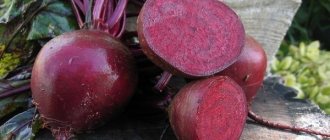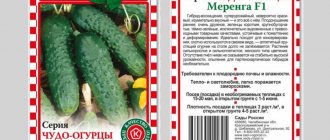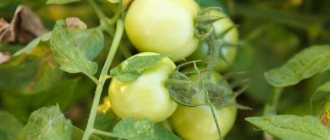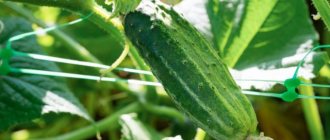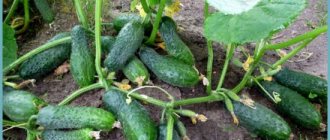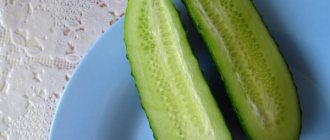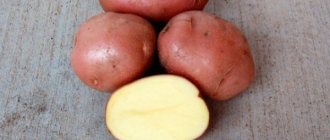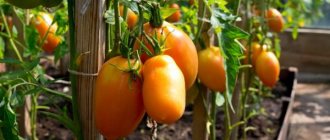The cucumber hybrid “Zozulya F1” is one of the outstanding achievements of Soviet selection. Work on its breeding was carried out under the leadership of Professor G.I. Tarakanov of the Timiryazev Agricultural Academy on the basis of the educational and scientific center (Moscow) by selection and seed production specialists. The hybrid was included in the State Register of Russia (in 1977) and Belarus (in 1981).
Cucumbers “Zozulya F1” are a Eurasian hybrid obtained by crossing lumpy European varieties with smooth Chinese ones
This variety was zoned for 54 regions of the USSR in the 1st-7th light zones and is recommended for cultivation throughout almost the entire territory of Russia in early spring and summer in protected soil conditions: in unheated greenhouses, hotbeds and tunnels. Due to their relative shade tolerance, cucumbers also actively bear fruit indoors: on a windowsill or on a balcony.
We will talk about the features of this hybrid and the reasons for its high popularity in this article.
Description of the variety Zozulya
The Zozulya cucumber is an early ripening species. From the emergence of seedlings to the ripening of the crop, an average of 40-45 days pass. It belongs to parthenocarpic hybrids, suitable for growing under shelters, although it can produce a good harvest in open ground.
Cucumbers grow in an elongated cylindrical shape, sometimes with a slight bend. The greens are 14-24 cm long and weigh between 150-280 g. The skin is dense, but edible and does not taste bitter. The color of the cucumbers is dark green, rich, with thin stripes of a light shade. The bumps on the skin are small and there are not many of them. The spikes are the same color. The pulp is dense, with a high juice content. The taste is pleasant.
The pulp is dense, with a high juice content, the taste is pleasant
Interesting!
Zozulya cucumber F1 does not require pollination by bees. But if it is provided, the yield will increase.
How to achieve a generous harvest?
Zozulya is a partially parthenocarpic plant. There will be a harvest without pollination, but it will not be high. It can be increased by planting a pollinator - 2-3 male plants in each row.
An important condition for obtaining a generous harvest is proper cultivation of plants. Zozulya is also suitable for open ground, but gives maximum results in greenhouses and greenhouses.
To stimulate the harvest, it is important to harvest it correctly. It is recommended to do this at least every 3-5 days. Thanks to this technique, more new fruits are formed.
How to get a generous harvest of cucumbers in open ground, as well as in a greenhouse - learn from the video:
Characteristics of Zozulya F1 cucumbers
Also check out these articles
- How to properly plant radishes in a greenhouse and open ground
- Planting garlic in the fall
- Williams pear variety
- Self-fertile apricot varieties
The Zozulya cucumber is famous for its positive qualities, so it is not surprising that gardeners often choose it for growing.
- The variety does not require pollination, so it is easy to grow in greenhouses and greenhouses (under cover).
- There is immunity to spotting and cucumber mosaic virus.
- The plants are strong and grow well even under unfavorable conditions.
- Their purpose is mainly salad, but these cucumbers taste good when preserved.
Their purpose is primarily for salads, but these cucumbers taste good even when preserved.
- Thanks to their dense pulp and durable peel, greens are suitable for transportation over long distances.
- The Zozulya cucumber has an attractive appearance and a pronounced aroma, so its commercial qualities are high.
- Fruiting is long and friendly.
- From each square meter of plantings you can collect 15-25 kg of Zozulya F1 cucumbers.
Interesting!
Zozulya cucumbers have small, tender seeds, so they are suitable for preparing summer salads.
Productivity
The Zozulya hybrid, with proper agricultural technology in a heated greenhouse, can produce an average of 12 kg, and a maximum of 20 kg per square meter of usable area. Even at the beginning of fruiting, this variety will delight you with a yield of up to 10 kg of fruit per square meter. It is impossible for the fruits to outgrow, so it is advisable to harvest them daily, cutting off the stalk with a sharp knife.
It is better to harvest more often, then the yield will be higher. This should be done once a day.
Disadvantages of a hybrid
The main disadvantage of this hybrid is that when grown in open ground, the variety's yield decreases. On average, from a square of plantings in unprotected soil, you can harvest 10 kg of cucumbers.
It is also necessary to take into account that greens can grow in irregular shapes, bend, and take the shape of a light bulb. This is especially observed in hot summers, when the temperature outside or in the greenhouse is too high.
The main disadvantage of this hybrid is that when grown in open ground, the variety's yield decreases
Important!
Zozulya F1 cucumbers are a hybrid, so they cannot be grown from seeds obtained from the harvest! Seeds for planting are purchased from year to year.
Bitterness appears only when the watering regime is disrupted. Cucumbers that lack water always taste bitter. So if you simply water the bushes on time and make sure that the soil does not dry out, there will be no problems with the taste.
Growing
There are a lot of varieties and hybrids. But preference is given to those that begin to bear fruit earlier and have favorable returns. And at least relatively resistant to diseases. These include the hybrid Zozulya.
The specificity of highly productive hybrids is that their seeds cannot produce a high yield in the second year of planting. Therefore, you should not prepare planting material for future use.
In order for the greens to please with their early ripening and productivity, it is necessary to properly prepare the soil for sowing and identify the predecessors.
Predecessors:
- Peas.
- Corn.
- Legumes.
Acceptable predecessors are potatoes, tomatoes.
Soil preparation
The culture is very demanding on soil fertility. Therefore, before spring digging, fertilizers are applied. They can be either organic (up to 100 kg of manure per 10 square meters) or mineral:
- 250 g potassium salt;
- 200 g ammonium nitrate;
- 400 g superphosphate;
Applying mineral fertilizers in the fall is not enough for greenery. Before planting, you also need to add a little humus and 150 grams of ash into the holes.
The beds are dug up in the fall after applying fertilizers, and harrowed in the spring. If clay or loamy soils are swollen, then in the spring you need to loosen them again.
Preparing seeds and growing seedlings
The seed material is heated and soaked in a weak solution of potassium permanganate for 15 minutes. Wash in water and place between layers of damp gauze. Maintain a temperature of at least 20 degrees. As soon as the seeds hatch, they are sown in pots. The temperature is maintained the same. A high yield can be obtained from 20-day-old seedlings.
Potassium permanganate is a good way to disinfect seeds. Price from 34 rub.
Growing on a trellis
Hybrid Zozulya is grown on a trellis. Positive aspects of this process:
- greenhouse cucumbers need it. Since, for example, this variety hardly branches, but has one central stem;
- the land plot is used rationally;
- plantings are better warmed up and blown by the wind;
- the leaves do not come into contact with the ground, and no drops remain on them after watering. That is, the risk of infection with fungal diseases is reduced.
Therefore, twine or wire is pulled onto any supports that are placed at the beginning, center and end of the row. The plants are tied to the bottom row, and then it clings to itself with tendrils and rises.
Now there is a special cucumber net on sale, which simply needs to be secured between the supports and the plants themselves, fastened to it with tendrils, rise up.
In the open ground
The Zozulya hybrid is a greenhouse plant, but in the southern regions it can be grown in open ground, either by planting seedlings or by sowing seeds directly into the beds. Some vegetables need to be specially shaded, but Zozulya cucumbers will not suffer from lack of light. The culture tolerates slight shading. Therefore, they are placed under trees or even near corn, which can serve as a support for the plant in the future. Read the link for planting tomatoes in open ground.
Sowing
The best sowing pattern is 10 x 70 cm. That is, the interval between seeds is up to 10 cm, and the row spacing is 70 cm.
Cucumber does not tolerate low temperatures very well, so sowing begins when the soil temperature is at least 15 degrees at the planting depth. Sow in three or four terms at intervals of five to seven days. Typically, the depth of the grooves for planting is up to 4 cm.
Care
After the first shoots appear, it is necessary to carry out loosening, and when the first real leaf appears, then breaking through. If this is a row, then the distance between the sprouts should be 15 cm, and 3 plants should be left in the holes. At this time, the first feeding is carried out with mullein and ammonium nitrate.
It is better not to use potassium chloride for fertilizing.
The second feeding is two weeks after the first. The third is carried out before closing the lashes.
Water the furrows after 3 days with 400 liters of water per 10 square meters.
In greenhouses
Greenhouse cucumbers are grown in heated greenhouses at 21–25 degrees.
Seedlings can be planted directly into the soil, freeing them from the containers in which they were grown. Before planting, the substrate should be moistened. If the seedlings grew in peat cups, then they are planted that way. Zozulya grows very quickly in a greenhouse, so regular watering and fertilizing with liquid fertilizers are needed. But you can’t over-moisten the soil either.
The plants are tied up, and when it reaches the roof of the roof, the top is pinched. Pinching the side shoots into two leaves will help speed up fruiting. The plant independently regulates the number of fruits, so do not be upset when some flowers begin to crumble. Thus, the rules of agricultural technology are quite simple:
- obligatory tying of bushes to the trellis and pinching of the tops;
Rules for pinching cucumbers
- constant irrigation, but not waterlogging of the soil;
- fertilizing with fertilizers at least 3 times per season;
- loosening and destruction of weeds;
- pest and disease control.
Zozulya cucumber seedlings
We recommend reading our other articles
- Grape variety Isabella
- Potato variety Tuleevsky
- Tomato variety Malinovka
- Rabbits of the Flanders breed
The easiest way to grow Zozulya F1 cucumbers is using the seedling method. Seedlings are prepared in advance. Seeds are sown between April 20 and May 1. The soil for sowing is made from 5 parts peat, 3 parts humus and 2 parts turf. After mixing in a seedling box, the planting soil must be treated with a weak solution of potassium permanganate.
The seeds must be soaked in advance for 30-60 minutes in clean, plain water. Everything that floats up is removed, as they are empty. After this, you can sow the seeds in holes or furrows made with a pencil. Sow them at a distance of 5-6 cm from each other so that they can develop freely.
The easiest way to grow Zozulya F1 cucumbers is using the seedling method.
Important!
If the seeds have an atypical color - colored, then they have been treated with special agents against diseases, and therefore they cannot be soaked before planting.
The first sprouts appear at a temperature of +25...+28 degrees, but after the sprouts appear, it is lowered to +21 degrees so that the sprouts do not stretch. They take care of the seedlings constantly. It is necessary to water from time to time, fertilize with weak solutions of fertilizers and loosen the soil. When the seedlings have 3-4 leaves (on average 3 weeks after sowing), they can be transplanted to a permanent place.
How to grow your own
To grow this hybrid in a greenhouse, you should choose a flat, sunny area that will be protected from the wind . The soil should be light and fertile.
If the soil is of poor quality, fill the greenhouse with a mixture of peat soil and humus. Before planting, the soil is disinfected. To do this, dissolve 3 g of potassium permanganate in 10 liters of hot water and water the ground generously.
Other varieties of cucumbers:
How to grow Harmonist cucumbers and why they are good
Hybrid "Connie f1", resistant to weather and diseases
Bee-pollinated variety of cucumbers “Graceful”
Planting by seeds and seedlings
The seed method is rarely used, only if there is a film cover . Seeds are soaked in water for an hour before sowing. The copies that surfaced are unusable and are thrown away. Those that have sunk to the bottom are rinsed, wrapped in a damp cloth and placed in a warm place for several days.
As soon as the sprouts appear, they begin sowing. Holes are made in the rows every 30 cm. Some of the humus and fertilizer is poured into the bottom of each dug hole, after which 0.5 liters of water are poured. After absorbing the moisture, place three seeds into the holes and sprinkle with dry soil. Sowing begins after the air warms up to +20 °C.
Reference. Sprouted plants are thinned out, leaving only strong crops in the hole.
With such cultivation, an important condition is that each seed germinates and turns into a full-fledged plant.
Stages of growing seedlings:
- Warming up . Even the best seeds may not sprout. To avoid this, warm up. Several months before sowing, cucumbers in bags are placed near heating devices, the temperature of which is about +30 °C. If it is higher, then you can reduce the duration of the procedure by a couple of days. This will increase the likelihood of good seedlings and increase the number of flowers on the bushes.
- Calibration _ The process is similar to sowing cucumbers in the ground. The seeds are poured with clean water or a mixture with potassium permanganate. After some time, the water is poured out. The seeds that rise to the surface of the water are thrown away, leaving only the sunken ones.
- Germination . The seeds are wrapped in damp cloth and placed in a warm place with a temperature of +30 °C for several days. You cannot place them in gauze, as the roots of the sprouts will get tangled and stuck, which will complicate the task and increase the possibility of damage to the seeds.
- Landing . The seeds are sown in special cups with a mixture of soil. From the moment of sowing until the appearance of the first shoots, the temperature is maintained at +30 °C. When the first leaf appears, it is lowered to +20 °C to prevent the seedlings from stretching.
The bushes are regularly watered and ventilated . It is important that there is about 13 hours of daylight. After a month, the seedlings are ready to be planted in the greenhouse. Holes 15 cm deep are dug in special rows and humus and fertilizers are added to them. The seedlings are carefully shaken out of the pots and placed in the holes. Then they are covered with earth and lightly compacted.
Growing and care
In order for the Zozulya hybrid to produce a good harvest, it is important to follow the rules of agricultural technology. Cucumber vines should be tied to supports, weeds should be removed, and the ground should be loosened . Be sure to water the plants and fertilize the crops with vitamins and fertilizers.
The hybrid is demanding on moisture, so water consumption is 1 liter per adult bush . The result will be better if you add combined organic-mineral fertilizers and fertilizers. They are applied at the root and along the leaves. The hybrid responds well to concentrated chicken manure.
It’s easy to prepare: dry droppings are poured with water in a 1:1 ratio. The vessel with this mixture is closed and left for a week. The mixture is used in diluted form.
Features of cultivation and possible difficulties
To prevent early seedlings from suffering from temperature changes , it is recommended to cover the seedlings immediately after planting. Since cucumbers love moisture, seedlings are watered abundantly. Leave the water for several days to warm it up - cold watering harms the plant. Excess moisture can negatively affect the hybrid, causing disease.
The best time for watering is morning or evening . Loosening is done to provide air to the root system and to prevent weeds from feeding on important nutrients from the soil. To develop and improve the bush, pinch the central sprout. This method also saves cucumbers from infertility.
Reference. Fertilize every two weeks.
Diseases and pests
The hybrid has good resistance to olive spot and root rot. But there are other diseases that can affect the plant . These include powdery mildew, ascochyta blight and bacteriosis. Fungal diseases are dangerous due to high humidity in the greenhouse.
To prevent these diseases, seeds are treated with fungicides “Vincit” and “Saprol”. When grown in greenhouses, the walls and ceiling are treated with a formaldehyde solution.
If the disease has already spread, the affected leaves are removed and burned, and the plants are sprayed with Bordeaux mixture or a solution of urea with copper sulfate, and the stems are rubbed with a mixture of copper and chalk.
Among the traditional methods of combating fungal diseases, the following are popular:
- treatment with fermented milk whey diluted with cold water in a ratio of 1:10;
- iodine solution - 25 ml of iodine dissolved in 10 liters of water;
- onion decoction - 0.7 liters of onion peel is boiled for one minute in 10 liters of water, left for 12-15 hours, diluted with water in a ratio of 1:4, then sprayed on the plants and watered the soil.
To combat the invasion of aphids, which sometimes infect cucumber beds, gardeners use insecticides (“Decis”).
Features of Zozuli planting
In order for cucumbers to produce well, they must be planted in good soil. The site is selected to be sunny and flat so that the light is evenly distributed among the rows. The best predecessors are onions, garlic, potatoes or green manure. The soil should be light, fertile, with neutral acidity.
Planting time depends on the climate and the place where the cucumbers will be grown. Most often this is done in May. But it is advisable to do this after the soil has warmed up to +20 degrees.
Important!
Cucumbers should be planted no closer than every 20-30 cm. If planted more densely, the grown vines will begin to compete for sunlight, development will slow down and the harvest will ripen later than expected.
In order for cucumbers to produce well, they must be planted in good soil.
The seedlings are transplanted into well-fertilized, loose soil. It is necessary to make holes in it at a distance of 35-50 cm from each other, about 15 cm deep. To make the sprouts take root faster, you can add a handful of humus, 0.5 tsp, to each hole. superphosphate and the same amount of potassium salt, and then water generously. When the water is absorbed, the planting itself can be carried out. The seedlings are carefully removed from the old container and lowered into the holes. Sprinkle them with soil carefully so that the growing point is not buried.
Important!
To prevent cucumber seedlings from being injured during final transplantation into the ground, it is worth sowing the seeds directly into peat or paper cups.
If the seedlings are weak, 3 sprouts are planted in each hole at once. When they grow up, you can choose the strongest one and plant the rest or simply remove them.
Landing
Zozulya is grown by seedlings in regions with cold climates. For the central part of the country, you can plant the seeds directly in the prepared soil, or you can start by growing seedlings. Young grown plants grow faster in open ground, have stronger immunity and bear fruit faster than cucumbers originally planted in the ground.
The soil for cucumber seedlings should contain peat, turf soil with a neutral pH. If the soil is light and fertile, the seedlings will quickly take root and the harvest will ripen in the near future. Poor soil is pre-fed with the following composition:
- 5 kg of peat;
- 2 kg of turf;
- 3 kg of humus.
The number of components is indicated per 1 sq.m. The substrate is mixed and laid on the bed, the layer should be 15-20 cm. The prepared bed is disinfected and watered. After a few days you can start planting.
Planting time varies depending on weather conditions. Grains are sown in the greenhouse when the temperature inside is between 23-25 degrees Celsius. Seedlings can be planted at a temperature of +20 degrees. The most optimal time to transplant seedlings into a greenhouse is mid-May.
Attention! Zozulya reacts sharply to the lack of lighting. Daylight hours should be between 13-15 hours. If there is not enough light, the seedlings need to be illuminated with lamps.
Rules for caring for Zozulya F1 cucumbers
After planting, it is necessary to provide the seedlings with proper care. This is not difficult to do, since the variety is unpretentious.
- Watering must be done regularly so that the soil does not dry out. If there is not enough water for cucumbers, bitterness will appear in the skin and pulp! At least 500 ml of water should be spent on a young plant at a time, and 1 liter on an adult. You need warm water, ideally rainwater.
Watering should be done regularly so that the soil does not dry out.
- If it is very hot outside, so that the root system does not overheat along with the soil, you can mulch the rows and root zone. In this case, it will be easier for cucumbers to survive the hot period.
Important!
Even with short-term drought, the yield and quality of cucumbers decreases! So watering must be carried out with good regularity.
- Loosening the soil is necessary after each watering. If the earth becomes crusty, oxygen will no longer be supplied to the roots in sufficient quantities, and development will slow down.
- Due to limited lateral branching, Zozulya cucumbers, as a rule, do not pinch.
- Weeds that appear between rows and under cucumber bushes must be constantly pulled out. This will be a good prevention of diseases and pests and, in addition, during this procedure the soil is fluffed up, so less weeding will be required!
- Plants respond well to fertilization. For this you can use organic matter, minerals or organomineral (OMM) preparations. Fertilizer is applied at the root or sprayed on the leaf (depending on the type). The first feeding is needed when 1 leaf appears (infusion of chicken manure, nitrophoska). The second time fertilizer is applied after the appearance of 2 leaves (potassium sulfate, chicken droppings). The third time, feeding is done the same as the 2nd time, after 2-3 weeks. Well, at the beginning of flowering it is also worth using fertilizers (ammonium nitrate or urea).
Zozulya F1 responds well to fertilization
Important!
If the watering regime is incorrect, voids may form inside the cucumbers.
Zozulya cucumbers can bear fruit without pollination. But the yield will be at an average level. If you additionally pollinate the plants by hand or bring bees into the greenhouse, there will be much more ovaries.
Features of care
To obtain a high yield from the Zozulya f1 variety, you will need to follow all the recommendations for caring for cucumber bushes.
Weeding and loosening
The soil in which Zozulya cucumber seedlings grow needs to be saturated with oxygen. Therefore, gardeners recommend loosening the soil around the bushes from time to time. This should be done carefully so as not to damage the root.
As for weeding, this procedure is necessary to destroy weeds. Therefore, it is recommended to weed the beds throughout the growing season.
Watering mode
You will have to water the cucumber bushes daily. Each plant requires about 1 liter of water. The hot May sun will quickly dry out the soil, which can affect the harvest. It is better to water early in the morning or in the evening. If you water during the day, the water will quickly evaporate and settle on the leaves and stem. This can lead to the development of a rotting process.
Top dressing
For this purpose, mineral and organic fertilizers are used. You can combine them, so the feeding process will be more effective. It is recommended to fertilize Zozulya cucumbers once every 2 weeks.
Nitrophoska
Suitable for all types of soil. This type of nutrition will help resist diseases. Can be used from flowering to fruiting. Dissolve 1 tbsp in 10 liters of water. nitrophoska and add 1 tbsp. chicken droppings. Apply 2 liters of fertilizer to each Zozulya cucumber bush.
Potassium sulfate
It will increase resistance to diseases and strengthen the plant. For 10 liters of water take 1 tsp. potassium sulfate and 0.5 tsp. infusion of chicken manure. Apply under the bush once every 2-3 weeks. Fertilizing is applied during the 2nd phase of the true leaf.
See also: How to properly soak cucumber seeds before planting
Ammonium nitrate
This is the most affordable nitrogen fertilizer that Zozulya cucumbers need for good growth and fruiting. You can sprinkle saltpeter on the ground around the bushes, or you can prepare a solution. For this, 10 g of saltpeter is used per 10 liters of water. Water the soil.
Important! It is prohibited to use ammonium nitrate during fruiting, since the fruits will absorb all the pesticides. It is also impossible to spray the plant with the prepared solution - this can lead to burns of the foliage.
Urea
Most often, a mixture of a liter of urea and 10 liters of water is used. Stir well and water each bush. Fertilizer will increase resistance to disease and improve fruiting.
Infusion of chicken manure
Such organic feeding will increase the yield of the Zozulya f1 hybrid by up to 40%. Dry granules (store-bought) should be scattered on the ground and dug up. Making an infusion is not difficult. To do this, take 1 kg of litter and fill it with 50 liters of water. Leave for a day.
Diseases and pests
Zozulya f1 has high resistance to diseases. But sometimes, if the care rules are not followed, it happens that pests attack cucumber bushes.
Ascochyta blight
Fungal disease. Greenhouse cucumber plants are most often affected. The fungus attacks the leaves and stem. This leads to withering and rotting of the Zozulya hybrid. You can overcome it with a solution of copper sulfate and chalk (proportions 1:1). Spray the root collar with liquid.
Anthracnose
Leaf blades are affected, and the fruits become bitter and rot. To treat Zozulya cucumbers, fungicides are used, for example, Previkur, Fitosporin, Quadris, Fundazol.
Bacteriosis
Brown spots appear on the leaves of the bush. As the disease progresses, holes form in their place. The fruits become watery, tasteless, their shape becomes distorted, and the skin becomes covered with pathogenic wounds. Treat with 1% Bordeaux mixture (a common fungicide).
Downy mildew
The leaf blade of the Zozulya hybrid is covered with yellow spots that have a purple coating. The leaves become distorted and dry out. Such remedies as Topaz, Tilt KE, Bayleton, Skor, Sulfarid will help overcome fungal infection.
Aphid
Insects infect the lower part of the leaf and stems of Zozuli. Eating by aphids of vegetable crops leads to yellowing and rotting. To combat pests, gardeners use various folk methods based on laundry soap, onion peels, garlic, potato infusion, as well as chemicals. Among them are Actellik, Alatar, Inta-vir, Fitoverm.
How to shape
To get a strong and healthy cucumber bush, you need to pinch it. The stem is pinched at the level of 6 leaves to a length of 20-21 cm. The plant throws out new shoots, on which flower stalks eventually appear. This procedure will significantly increase the amount of harvest. You can start forming a bush from the moment when the Zozulya f1 cucumber seedlings take root in a new place (in the beds or in the greenhouse).
For this it is recommended:
- tie the main stem to the trellis;
- after the ovaries appear on the side shoot, pull it 60 degrees closer to the main stem;
- twist the mustache from the main stem with a side shoot.
It is especially important to carry out this work when planting seedlings frequently.
Diseases and pests of cucumbers
Zozulya cucumber is resistant to most diseases, but illnesses cannot be completely avoided.
- Ascochyta blight appears as watery spots with black dots on the petioles of leaves and stems. As a result, the stem dries out and brown spots with black dots appear on the leaves. To prevent disease, the greenhouse must be ventilated regularly. If a disease is noticed on a plant, it is immediately pulled out and burned.
- Anthracnose appears as brown spots on the leaves and brown indentations on the stem. The fruits begin to rot quickly and taste bitter. Prevention is the same as in the previous case. If the disease appears, all diseased plants are removed from the site.
- Bacteriosis manifests itself in brown spots on the leaves, and over time, holes appear in their place. The fruits grow crooked, watery, with ulcers. For treatment and prevention, Bordeaux mixture is used according to the instructions. It is also important to ventilate the greenhouse in a timely manner, maintain normal humidity and temperature there.
Fungicides for the treatment and prevention of cucumber diseases
- Downy mildew is a disease characterized by yellow spots on the leaves and a purple coating. Over time, the leaves curl outward and dry out. To treat and prevent the disease, you need to use fungicides “Fitosporin M”, “Gamair”, “Orvego”, “Tiovit Jet”, “Abiga-Pik”, “Topaz”, “Consento” and the like.
- Powdery mildew is noticeable by a white coating on the leaves. Over time, the plaque darkens, the fruits grow twisted and bitter. For treatment, the same fungicides are used as for downy mildew.
Important!
In order for cucumbers to get sick less often or not to get sick at all, they need good care.
Pests do not often attack this hybrid. But even if this happens, with timely treatment they will not cause much harm to the plant. Most often, aphids settle on the pagons. It is easy to notice if you look closely at the tops of young shoots and the back side of young leaves. To remove the pest, you can use insecticides “Arrivo”, “Tanrek”, “Fitoverm”, “Aktofit”, “Aktara”.
Harvesting and processing
Cucumbers ripen gradually. It is best to collect them every 3-5 days so that they do not hang on the vines for a long time. In addition, timely harvesting provokes the setting of new fruits. The first greens ripen already in June or early July, if planted in a timely manner.
Important!
If the greenhouse is very hot or the cucumbers do not have enough water, the greens will begin to warp and become bitter.
Zozulya F1 cucumbers are most often used for preparing salads and fresh snacks
Greens are consumed fresh. They can be used to prepare salads and fresh snacks. Is it possible to pickle or preserve Zozulya cucumbers? As a rule, this kind of cucumbers is not used for pickling. But many housewives note that Zozulya cucumber is also suitable for canning. If you soak the greens in water in advance and choose a good marinade recipe, they will turn out tasty and crispy.
Characteristics of the variety
In the greenhouse, Zozulya cucumbers show the best yield results. It is optimal to consider the characteristics of a crop precisely under the condition of a closed growing method.
Productivity and fruiting
The hybrid variety Zozulya f1 is considered an early ripening crop. The ovary appears approximately 48 days after seed germination. The first wave of the harvest is small. Up to 16 kg of fruits are collected from 1 m2. After a month, the crop increases its fruiting rate. The yield of the next waves of the Zozulya variety exceeds 20 kg per 1 m2 of bed.
Application area
Zozulya f1 is considered a salad cucumber variety. The fruits are eaten fresh, used to decorate sandwiches and prepare vitamin-rich salads. Cucumber is not suitable for preservation. It is undesirable to use the vegetable in pickling; the cucumber pulp becomes soft and tasteless. Young small cucumbers can be pickled, but they will not be as crispy as gherkins.
Resistance to diseases and pests
The cucumber hybrid Zozulya is distinguished by its good resistance to mosaic, various types of rot, and spotting. Dangerous pests include spider mites, whiteflies, slugs, and aphids. To prevent damage to the crop, a good microclimate is maintained in the greenhouse and preventive spraying is carried out.
Advantages and disadvantages of the variety
Even looking at a photo of Zozulya cucumbers, you can immediately fall in love with this vegetable. Beautiful fruits just beg to be put on the table. The main advantages of the variety include the following:
- early ripening of the crop;
- the bush grows without pinching;
- self-pollination without the participation of insects;
- high yield of the variety;
- delicious juicy fruits.
Of the negative qualities, only two indicators can be distinguished: the variety produces optimal yields only in a greenhouse, the fruits are not intended for preservation and pickling.
Reviews from gardeners about the Zozulya cucumber variety
The opinions of gardeners who have already tried to grow Zozulya cucumbers on their plots are presented below.
- Antonina Dusha : “I heard a lot of flattering reviews about Zozulya cucumbers, so I decided to plant them on my plot. I planted it in open ground, behind the house, where there is a lot of sun. The cucumbers grew to a normal size, but some were bitter. Most likely, they were very hot, since the summer turned out to be hot. In principle, the variety is not bad, but I won’t plant any more, since heat in the summer is not uncommon in my region!”
- Sergey Metelkin : “I love Zozulya cucumber for its pleasant taste and high yield. I only grow them in a greenhouse because they produce less fruit in open ground. In principle, they have no problems with growth, there are always a lot of ovaries, you just need to make sure that the temperature is moderate (not hot) and that the soil does not dry out. If you provide cucumbers of this variety with good care and normal conditions for development, they will produce so much harvest that there will be enough for both food and canning!”
- Sofia Seledochkina : “Just by one type of Zozulya cucumber, you can understand that they are for salads. And yet, last year I tried to preserve them, because there were no others - the pickling varieties did not produce well. Not surprisingly, these cucumbers turn out quite good in jars. Of course, they don’t crisp up like pickled ones should, and they don’t absorb the spicy marinade so well, but they’re also not bad – for a change. But I highly recommend not salting them. Their taste is bland, and the flesh softens.”
Advantages and disadvantages
The advantages of Zozulia include early ripening and ease of care due to the absence of the need to attract insects for pollination. Other advantages are unpretentiousness and resistance to many diseases, high yield and juicy taste of the fruit.
The hybrid has few disadvantages . These include the fact that for increased productivity it is necessary to grow the plant only in protected and specially prepared soil.
